10 Fat Turkeys
Written by Tony Johnston
Illustrated by Rich Deas
Scholastic, 2004
10 Fat Turkeys is a “backward” counting book modeled on the Ten Little Indians rhyme that would be fun to read at Thanksgiving time with very young children.
As the book begins, we see 10 fat turkeys "fooling" on a fence—one is reading the Turkey Times…one is strumming a guitar…one is dressed in a tux…one is wearing a bathing cap and googles.
The 10…9…8 countdown begins like this:
GOBBLE GOBBLE WIBBLE WOBBLE
Do a noodle dance.
10 fat turkeys,
Fooling on a fence.
“Looky!” says a silly turkey,
Swinging from a vine.
GOBBLE GOBBLE WIBBLE WOBBLE
Whoops! Now there are…
9 “Looky!” squawks a goofy turkey,
Trying to roller-skate.
GOBBLE GOBBLE WIBBLE WOBBLE
Ooops! Now there are…
I think you can figure out what comes next.
Finally, all the turkeys are gone…and so is the fence. Not to worry though. At the end of the book, we see that the turkeys have found a new place where they can gather together and start fooling around once more.
The humorous illustrations by Rich Deas add to the fun of the goofy, goony, loony turkeys' shenanigans.
Click here to look inside this book.
GIVING THANKS
Written by Jonathan London
Paintings by Gregory Manchess
Candlewick, 2003
Giving Thanks is not a picture book about the Thanksgiving holiday. I would describe it as more of a paean to nature than a story. It is a book about a boy who is learning a deep respect for and appreciation of the natural world and the creatures that inhabit it from his father.
The book is set on an autumn day. The boy and his father go off on a walk through meadows and the woods. The father gives thanks for all the gifts of nature they see on their daylong outing—including frogs and crickets singing down by the creek; the tiny beings with six or eight legs, weaving their tiny stories close to the earth; chanterelles, the wild mushrooms that smell like pumpkins; deer who have passed this way, their tracks like two fingers pressed in the dirt.
The book’s text is brief and oft times lyrical. The oil on canvas illustrations done by Manchess are gorgeous. Their broad, visible brushstrokes and blurred outlines bring to mind an impressionistic style of art. Shifting perspectives and close-ups keep this quiet book from becoming static.
Reading and discussing Giving Thanks with children might help to imbue them with an appreciation and respect for animals and other riches of nature that are so often taken for granted. It would be a fine book to read aloud in the classroom or to one’s own children before taking them on a nature walk. It’s also an excellent book about father-son bonding.
Note: Jonathan London dedicated this book to Joseph Bruchac, the award-winning Native American author and storyteller whose family founded the Ndakinna Education Center, a not-for-profit organization located on the Bruchac Nature Preserve in Greenfield Center, NY.
THANKSGIVING IS HERE!
Written & illustrated by Diane Goode
HarperCollins, 2003
There isn’t much of a story in this book. It's a depiction of a joyful—and hectic—celebration of Thanksgiving as experienced by one large family.
Grandma arises early on Thanksgiving morning to get the turkey into the oven. Then, through the course of the day, relatives arrive—along with their children, a baby carriage, an enormous “special” present, knitting needles and yarn, a violin—and even a dog. Family unites to help with dinner preparations, the moving of furniture, and setting of tables.
Goode’s text curves and swerves above and below her light-hearted, cartoon-style illustrations, which add happy and humorous details to the story. Much of this holiday extravaganza is told through her art. In the pictures, we see children hiding under a table, adults reading to children, some relatives dancing while another relatve plays the piano, older family members sleeping on chairs and sofas after their huge turkey dinner, a young boy playing the violin while standing atop a table, a crying baby, and one of the youngsters pulling off an elder’s toupee.
Thanksgiving Is Here! is a celebration of families…of relatives of all ages gathering together for one of the most special occasions of the year.
THE THANKSGIVING DOOR
Written & illustrated by Debby Atwell
Houghton Mifflin (Walter Lorraine), 2003
I am quoting from the blurb printed on the back of the paperback edition of The Thanksgiving Door because it explains so succinctly and so well what this story is all about: “On Thanksgiving Day, an immigrant family opens their door to a couple of uninvited guests, sharing an evening of friendship, good food, and lots of dancing, and remembering that Thanksgiving is about opening one’s heart in welcome to the strangers who become friends and to the disappointments that bring unexpected joys.”
Ed and Ann are elderly. They’re home alone on Thanksgiving Day. When Ann realizes that their turkey has burned, she and Ed decide to see if the new restaurant down the street, which is owned by immigrants, is open for the holiday. Ed and Ann find the front door of the New World Café open. They step into the large dining room and see a long table that has been decorated and set for dinner. The restaurant is actually supposed to be closed for the holiday. The immigrant family is planning to have a big feast for relatives. The immigrants peer at Ed and Ann through windows in the kitchen door. They’re angry that intruders have made their way into the dining room. They’re sure their celebration will be ruined—and try to think of ways to scare the uninvited guests away.
But Grandmother feels differently. She believes they should share their meal and “turkey big as a doghouse” with the unexpected guests. The family decides that Grandmother is right. They add two more chairs to the table and welcome Ed and Ann to join them for dinner. And so, the members of an immigrant family open their hearts to an elderly couple and share not only food…but friendship--and their own special celebration of an American holiday in their adopted country.
It isn’t until the end of this heartwarming tale that readers find out that Grandmother had jammed a potato under the front door to keep it open. When Papa asks how it got there, Grandmother responds: “In old country Thanksgiving door is like happy heart, opened up big and wide.”
Atwell’s flat, folk-art-style illustrations are bright and colorful. They include lots of details and intricate patterns, which add visual interest. The intense warm colors used in the second half of the book echo the warm feelings of friendship and acceptance expressed in her story.
Although the ethnicity of the immigrant family is never stated in the text, Atwell provides plenty of visual clues for discerning readers in her illustrations: a painting of buildings with onion domes hanging on a dining room wall; the boxy, brown fur hats worn by the men; and family members performing what appears to be a Russian Cossack dance.
Squanto’s Journey
The Story of the First Thanksgiving
Written by Joseph Bruchac
Illustrated by Greg Shed
Silver Whistle/Harcourt, 2000
This historical fiction picture book is an excellent informational read-aloud for the elementary grades. Bruchac narrates the story in the voice of Squanto (Tisquantum), a Patuxet Indian. The book opens with Squanto telling about his capture by Captain Thomas Hunt who took him and other Patuxets to Spain to be sold as slaves in 1614, how Spanish friars set Squanto free and helped him to get to England, and Squanto’s return to America in 1619 when he found that his people had been devastated by a disease. In the rest of the book, we learn about Squanto’s building a friendship with the Pokanokets and Nemaskets; Samoset, a Pemaquid Indian; the arrival of the Pilgrims on the Mayflower; and the relationship between Squanto and the English that helped the settlers at Plimoth make it through their first year in the New World. The book includes an author’s note and a glossary.
Milly and the Macy’s Parade
Written by Shana Corey
Illustrated by Brett Helquist
Scholastic, 2002
This is a story about a young girl named Milly whose family has immigrated to the United States from Poland. Milly’s father works at Macy’s Department Store. He—along with other immigrants who work there—miss their families and the holiday celebrations they had back in their homelands. Milly takes note of their feelings and gets a grand idea.
Meanwhile, Mr. Macy is concerned because his salesclerks are frowning instead of acting festive before the Thanksgiving and Christmas holidays. He thinks the salesclerks are depressing the customers. He’s trying to figure out a solution to this problem. That’s when Milly approaches Mr. Macy and explains her idea. She tells him how she thinks “Macy’s could bring a little bit of everyone’s home to America.” Mr. Macy is receptive to Milly’s suggestion that the store sponsor a celebration that will remind the homesick employees of their holidays back home. The following day the store posts a sign advertising its Christmas parade. Word spreads quickly.
On Thanksgiving Day, Milly, her father, and all the other Macy’s workers dress up in costumes and march in the holiday parade. They all enjoy singing and strolling down the street—just as they had done in the old country.
This is a highly fictionalized account of the origin of the famous Macy’s Thanksgiving Day Parade. Shana Corey includes an Author’s Note with background information on the parade—including the fact that it missed only three holidays. It was canceled from 1942-1944 because of World War II.
TURK AND RUNT
Story by Lisa Wheeler
Pictures by Frank Ansley
Simon & Schuster, 2002
Looking for a Thanksgiving story that will get young kids laughing? I recommendTurk and Runt. It’s a slyly humorous tale about two turkey brothers named Turk and Runt. The boys’ parents are extremely proud of their son Turk. He’s “the biggest, strongest, and most graceful bird on Wishbone Farm.” He’s a dancer and an athlete! What turkey parents wouldn’t puff out their chest feathers if they had a progeny like that? Turk’s parents are sure he’s going to go far in life. Bespectacled little Runt, however, knows exactly where Turk’s headed—not to fame and fortune, but to somebody’s house where he’ll be roasted and basted. Runt’s parents won’t listen to his warnings. They’re too wrapped up in their ambitious dreams for Turk.
Two days before Thanksgiving the famous ballet instructor Madame Waddelle arrives at the farm. “An audition!” squeals Turk’s mother. “Go out there and shake those tail feathers!” she tells her son. Turk leaps and spins…twirls and whirls. What a performance! The dance teacher is mighty impressed—especially with the size of Turk’s drumsticks.
Realizing that he’ll have to be the one to save his brother, Runt puffs out his feathers, throws himself to the ground, flaps and flops, hisses and sputters, gobbles like a maniac, and nearly scares the leggings off of Madame Waddelle. She runs away screaming: “Zees birds are crazy!”
But Turk’s not safe yet. The next day Coach Giblet arrives to select his Thanksgiving fowl. Turk’s father tells him to display his football prowess. Turk bobs and weaves, tackles and dives. He mows down every turkey in his path. The coach is in awe of this athletic bird. That’s when Runt comes to the rescue again. He cries and coughs and wheezes—he sniffles and sneezes and falls to the ground, hacking and quivering. “Good gravy!” shouts the coach sure that the turkeys are ill. He heads for the hills.
Runt’s parents are sad. Will their dreams for Turk’s bright future be realized? Maybe. When they see a little old lady driving onto the farm on Thanksgiving morning, they’re hopes are rejuvenated. They encourage Turk: “Show her what you’ve got!” But the elderly female isn’t interested in the robust Turk. She’s looking for a fowl of smaller stature—and Runt seems to be just the right size. His parents can’t believe it!
Knowing what the old lady has in store for him, Runt is on the run! That’s when Turk comes to his rescue. He uses the ballet moves and football maneuvers he’s perfected to help his puny sibling. When Runt gobbles like a maniac and Turk tackles her, the woman is finally frightened off.
Later that day, the thankful turkey family enjoys a feast of corn and alfalfa. But their happiness is shattered when Runt warns them that they’re not out of the woods yet. “Come December, folks begin planning their holiday dinners.” Readers have no need to worry about the fate of this fine fowl family. Runt’s got a plan—and you can be sure that this time everyone listens to him.
Ansley’s hilarious cartoon-style illustrations work perfectly with Wheeler’s humorous story. In this book, text and art combine to give readers one truly funny Thanksgiving tale.
Poetry for Thanksgiving
THANKSGIVING DAY AT OUR HOUSE
Written by Nancy White Carlstrom
Illustrated by R. W. Alley
Simon & Schuster, 1999
This poetry collection opens with a poem that is set on the day before Thanksgiving at an elementary school where kindergarten and first grade students are celebrating the holiday with a pageant. The fifteen poems in this collection take us through the school festivities as well as those of a family with three young children. I'll give you a flavor of the poetry you'll find in this book. Here is the first stanza of the first poem.
From The Day Before
All kinds of turkeys
are strutting the halls.
Finely feathered gobblers
are squawking out their calls.
The next two poems, The Mayflower and The First Thanksgiving, are recited by children dressed up as Pilgrims and Native Americans. In The First Thanksgiving, thanks are given for friends and for the foods that helped to sustain the Pilgrims: pumpkins, beans, and corn. This is how the three-stanza poem ends:
From The First Thanksgiving:
So thank you for corn
And thank you for friends.
On the earth and on others
We all must depend.
The rest of the poems take place at the home of the family hosting the Thanksgiving Day feast. There’s a poem in which Granny tells the children what it was like when she was a little girl. There are poems about activities that young and old relatives participate in before dinner: Thanksgiving Parade and Thanksgiving Charades. There are four poems about giving thanks: Thank You God for Bugs, Graces, Thank You Singing Game, and Goodnight Prayer. There is also Prayer for Others, a poem in which the children ask God to help Grandma to get better and to help those less fortunate than they.
I don’t want to leave the impression that all these poems and prayers about thankfulness and thinking about others lend a too-serious tone to the book. The poems are told from a child’s perspective and many are expressed with a childlike exuberance. In addition, R. W. Alley’s cartoon-style illustrations, rendered in pen-and-ink and watercolor, add a lot of levity and humor. They complement and extend the text. In the illustration for the poem Rhyme Time Thanks, Alley depicts a family busily preparing the Thanksgiving dinner. The painting abounds with lots of droll details: The dog has a slice of pie in its bowl; a mouse looks at cream that has spilled onto the floor as Grandfather whips the cream into a froth; the youngest child pushes a cat around the kitchen in a rolling baby chair.
Here’s an excerpt from The Way It Is at Our House, one of the most lighthearted poems in the collection.
Do Uncle Ernie’s socks match?
No! No! No!
Does Joey’s little dog scratch?
So! So! So!
Does Granny Nan tell funny jokes?
Ho! Ho! Ho!
Thanksgiving Day at Our House ends with Goodnight Prayer, a poem in which the young children of the family who hosted the holiday dinner express their gratitude for all the things they appreciate—including their happy feast, friends and relatives, blankets and toys, Papa’s singing noise and Mama’s kisses.








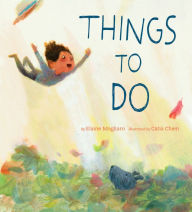

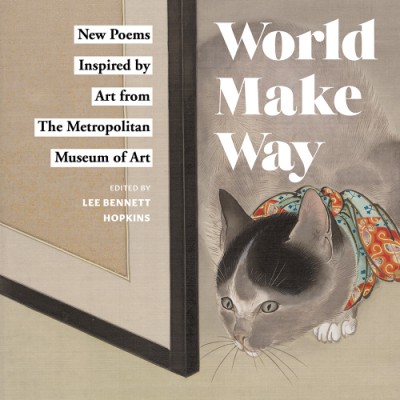



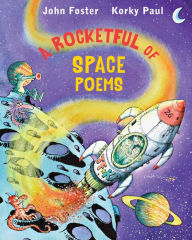
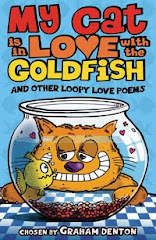
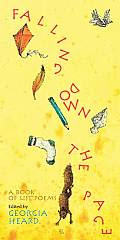

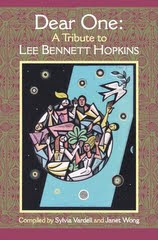
1 comment:
This is exactly what I was looking for. I decided this year that I was going to give Thanksgiving gifts to my grandchildren, and now (thanks to you I know exactly what to I want to buy).
Here's a gift for you. I wonderful Thanksgiving story....
Two teenagers organizing a neighborhood food drive to give thanks by giving to others. “Bridgett Jenkins recognized a memory in the making when her 13-year-old daughter, Stacy, and her pal Jaymie Grauman, 14, organized a neighborhood food drive late last week [November 1996]. ‘They were just sitting there, and they said 'Wouldn't it be nice to just help someone?' We've been there before,’ Jenkins said. "We know what it's like to be down and out.’ The girls used Jaymie's computer to design their fliers, then they hand-delivered them to the 150 homes in their neighborhood, Tibbitts Landing. That Sunday the girls got a little red wagon and started collecting. With the help of Jaymie's father and a few friends, they ended the day with 10 bags of groceries for the food bank at Elk Plain School. ‘They were really excited,’ Jenkins said of the Bethel Junior High School students. ‘They thought nobody would really put anything out.’ Now they know how one generous act leads to another.”
— Bridgett Jenkins
Stacy Jenkins
and Jaymie Grauman
Tibbitts Landing, Tacoma, Washington
Post a Comment